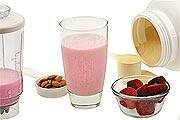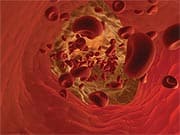Life Extension Magazine®
| The lifetime risk of developing high blood pressure is greater than 90% in adults 55 years and older.1 You may be one of them. Experts estimate that this silent killer accounts for 40.5 million doctor visits each year.1
Sadly, those visits often come too late. Poorly controlled blood pressure slowly damages kidneys and the vasculature, often culminating in heart attack, stroke, or kidney failure.2,3 Tens of thousands of deaths attributable to hypertension occur each year,1 yet most could have been prevented had corrective action been taken earlier in life. Published studies show that aging individuals who achieve a mere 5-point decrease in diastolic blood pressure can reduce their risk for lethal hypertension-related conditions by as much as 16%.4 In this article, you will learn of a discovery by a team of Cambridge researchers showing how to better manage hypertension using low-cost and readily available nutrient compounds. A Fascinating DiscoveryA recent study by researchers at the Cambridge Institute for Medical Research reveals the dangerous relationship between oxidative stress and angiotensin, a hormone that boosts blood pressure often to dangerous levels. Aiwu Zhou and colleagues decided to focus on angiotensin’s parent molecule, angiotensinogen.5 Using ultra-high resolution X-ray crystallography, Zhou’s team examined the underlying mechanisms driving high blood pressure. When oxidative stress is present, the angiotensinogen molecule shifts its shape and floods the system with angiotensin!5 This led to the discovery of an “oxidative switch” that impacts blood pressure status in the body. What Zhou’s team has done is to identify an entirely new mechanism between oxidative stress and hypertension. But nutritional scientists have long known that antioxidants confer some protection against hypertension. So Zhou’s work is fueling renewed interest in nutrients that fight oxidation and tip the balance away from angiotensin release. Recent discoveries show that a small handful of antioxidant compounds can inhibit the angiotensin-converting enzyme (ACE) itself, contributing to their antihypertensive effects. Let’s examine some of nature’s own antihypertensive interventions and how they can work to keep you healthy. Whey proteins derived from milk are antioxidants that may contribute to their antihypertensive properties. Whey ProteinWhey proteins derived from milk are antioxidants that may contribute to their antihypertensive properties.6-8 They also contribute to blood vessel relaxation and reduced “stiffness.”9 Professor Zhou’s discovery that antioxidant status directly affects angiotensin availability further explains how whey proteins may fight elevated blood pressure.5 Human studies of whey-rich or whey-enriched milk products demonstrate convincing reductions in blood pressure compared with placebo- or casein-supplemented patients.9-11
In recent years, scientists have found that whey proteins exert substantial direct angiotensin-converting enzyme (ACE)-inhibiting effects.12-14 In the human stomach and intestine, whey proteins break down into very specific short amino acid chains (peptides) that makes them efficient ACE-inhibitors.15-19 Laboratory studies consistently show that blood pressure is reduced in hypertensive animals given whey protein derivatives.20,21 That effect is attributed at least in part to ACE inhibition.21 The ACE-inhibitory effect is substantially less powerful than those of prescription drugs, but some people encounter side effects with those drugs.4,20 Whey protein derivatives, by contrast, can be used for long periods of time without significant problems.9 Recent work suggests that these active milk components also inhibit the release of other vessel-constricting molecules such as endothelin-1, offering a second pathway for blood pressure control.22 Together, all of these findings suggest that whey proteins can reduce the risk of hypertension-related disease.4,23 Let’s now look at other natural antihypertensive nutrients that can work together with whey to promote your cardiovascular health. Grape Seed Extract and ResveratrolGrapes contain many biologically active compounds, most notably multitargeted polyphenols such as resveratrol and proanthocyanidins, which are associated with improvements in cardiovascular risk factors.24 Extracts of grape seed are rich in beneficial compounds. Their constituents include antioxidants that reduce markers of oxidative stress, such as oxidized low-density lipoprotein (LDL), that are associated with atherosclerosis.25 Those antioxidant effects can directly prevent or treat elevations in blood pressure in laboratory animals.26 Grape seed extracts operate at multiple additional targets to achieve their beneficial effects on blood pressure. They fight advanced glycation end product (AGE) formation,27 an early step in producing inflammation associated with cardiovascular disease and cancer.28 This means that grape seed extracts hold promise not only in preventing hypertension, but also in fighting some of its deleterious effects, such as kidney damage.29
The effects of grape seed extract may also protect the heart. In an experimental model of heart attack, cardiac tissue from animals that had received grape seed extract was better able to recover from lack of blood flow (ischemia), compared with the heart tissue of animals that did not receive grape seed extract.30 Grape seed polyphenols can also reduce salt sensitive-hypertension in an animal model, which may further help push blood pressure into the normal range.31 Finally, grape seed extracts have been shown to induce cognitive improvements in impaired hypertensive rats.32 All of these mechanisms contribute to improved blood pressure control and result in the clinically relevant drops seen in blood pressure in human studies.33 Recent discoveries about resveratrol, a main component of the extracts, shed additional light on their mechanism and their potential. Resveratrol is one of the more fascinating biologically active molecules known to science. It has a plethora of beneficial effects, acting at several key metabolic switches to promote longevity and fight chronic disease. A powerful antioxidant in its own right, resveratrol also enhances activity of the SIRT-1 regulatory complex, which is associated with prolonged life span in a host of experimental models.34-36 Resveratrol also inhibits signaling molecules expressed by blood vessel cells that are implicated in hypertension.37 The polyphenol improves the way vascular endothelial lining cells react and respond to factors that control blood pressure.34 Preliminary research suggests that resveratrol may have ACE-inhibitory capabilities, adding to its potential for maintaining healthy blood pressure.38 Additionally, resveratrol may suppress some of the adverse effects of angiotensin II, such as vascular smooth muscle cell overgrowth (hypertrophy).39-43 In an animal model, resveratrol has also been found to help prevent cardiac hypertrophy induced by high blood pressure.44,45 Chronic cardiac hypertrophy can lead to cardiac dysfunction and heart failure.46 Angiotensin’s effects have been implicated in that process, and resveratrol can block those effects by its action on multiple pathways.45,47,48 In animal studies, resveratrol reduces pulmonary hypertension, the elevated pressure in arteries of the lungs that dramatically impairs quality of life in people with chronic heart disease.49
PomegranateThe pomegranate has demonstrated benefits for cardiovascular health and blood pressure control.50 Pomegranate juice and extracts are rich in some of nature’s most powerful polyphenols.51 Those molecules contribute to a reduction in cellular oxidative stress and help restore natural antioxidants to effective values. As we’ve seen, ameliorating oxidative stress in cells, particularly those of the vascular system, shows promise as an effective means of combating hypertension, because it limits production of angiotensin.5 Like whey proteins and grape seed extracts, however, pomegranate extracts also directly inhibit activity of the angiotensin-converting enzyme (ACE), helping to lower blood pressure.52 And like resveratrol, pomegranate extracts are effective at blocking some of the downstream damage induced by angiotensin in tissues vulnerable to hypertensive changes.53
In still a third line of defense, pomegranate supplements can increase levels of the antioxidant protective complexes called paraoxonases (PON).54 PONs are major components of high-density lipoprotein (HDL) and are widely recognized as providing much of the benefit we see from HDL.54,55 A fourth avenue of benefit from pomegranate extracts is their effect on vessel wall function. Oxidative damage leaves vessels vulnerable to damage at points where blood pressure is markedly increased by so-called shear stress. Pomegranate juice mitigates that damage by improving activity of endothelial nitric oxide synthase (eNOS), thus making more vessel-dilating nitric oxide available.56 The clinical benefits of pomegranate consumption on cardiovascular disease and blood pressure are undeniable. A landmark 2004 study from Israel demonstrated that pomegranate juice consumption for 3 years reduced carotid artery wall thickness in patients with narrowing of those arteries.57 The carotids are the major blood supplier to the brain, and thickening of those walls is a precursor to devastating strokes. That thickening is itself a direct result of chronic exposure to elevated blood pressure as well as abnormal lipid profiles. The patients in the Israeli study experienced an average of 12% reduction in systolic blood pressure by the end of the first year. Subsequent human studies have demonstrated improvements in blood flow to the heart and the brain in patients with cardiovascular disease, following pomegranate supplementation.58,59 And flow-mediated dilation, a measure of vessels’ ability to respond to pressure changes, is improved after consumption of pomegranate juice.60
SummaryBlood pressure elevations continue to threaten our longevity and our quality of life. We’ve known for years that people with a high intake of antioxidants tend to have lower blood pressures and to suffer less from cardiovascular disease in general. It’s only in the past decade, however, that we have begun to understand the biochemical underpinnings of that cardioprotective effect. We now understand that oxidative stress induces inflammation in blood vessels that impairs their ability to safely regulate blood pressure. Only in late 2010 did we learn that a state of high oxidative stress causes the blood pressure-boosting hormone angiotensin to become more readily available in the body. That discovery has set off a storm of interest in researchers aiming to control blood pressure by modifying oxidative stress in the body. Fortunately, solid scientific evidence abounds for the protective effects of three nutrients. Whey protein, grape seed extracts, and pomegranate extracts all work by restoring healthy antioxidant levels. We’ve learned that they each also prevent both activation of angiotensin and its destructive effects by a series of related but complementary mechanisms. Using all three together simply makes sense as a way to optimize your cardiovascular health. If you have any questions on the scientific content of this article, please call a Life Extension® Health Advisor at 1-866-864-3027.
Editor's NoteScience continues to evolve, and new research is published daily. As such, we have a more recent article on this topic: Around-the-Clock Blood-Pressure Control | |||||||||||||
| References | |||||||||||||
| 1. Vasan RS. Residual lifetime risk for developing hypertension in middle aged women and men: the Framingham study. JAMA. 2002;287(8):1003-10. 2. Loizzo MR, Tundis R, Menichini F, Statti GA. Hypotensive natural products: current status. Mini Rev Med Chem. 2008 Jul;8(8):828-55. 3. Moore J. Hypertension: catching the silent killer. Nurse Pract. 2005 Oct;30(10):16-8, 23-4, 26-7 passim; quiz 36-7. 4. FitzGerald RJ, Murray BA, Walsh DJ. Hypotensive peptides from milk proteins. J Nutr. 2004 Apr;134(4):980S-8S. 5. Zhou A, Carrell RW, Murphy MP, et al. A redox switch in angiotensinogen modulates angiotensin release. Nature. 2010 Nov 4;468(7320):108-11. 6. Chitapanarux T, Tienboon P, Pojchamarnwiputh S, Leelarungrayub D. Open-labeled pilot study of cysteine-rich whey protein isolate supplementation for nonalcoholic steatohepatitis patients. J Gastroenterol Hepatol. 2009 Jun;24(6):1045-50. 7. Laviolette L, Lands LC, Dauletbaev N, et al. Combined effect of dietary supplementation with pressurized whey and exercise training in chronic obstructive pulmonary disease: a randomized, controlled, double-blind pilot study. J Med Food. 2010 Jun;13(3):589-98. 8. Marshall K. Therapeutic applications of whey protein. Altern Med Rev. 2004 Jun;9(2):136-56. 9. Pal S, Ellis V. The chronic effects of whey proteins on blood pressure, vascular function, and inflammatory markers in overweight individuals. Obesity (Silver Spring). 2010 Jul;18(7):1354-9. 10. Kawase M, Hashimoto H, Hosoda M, Morita H, Hosono A. Effect of administration of fermented milk containing whey protein concentrate to rats and healthy men on serum lipids and blood pressure. J Dairy Sci. 2000 Feb;83(2):255-63. 11. Pins JJ, Keenan JM. Effects of whey peptides on cardiovascular disease risk factors. J Clin Hypertens (Greenwich). 2006 Nov;8(11):775-82. 12. Vermeirssen V, Van Camp J, Augustijns P, Verstraete W. Angiotensin-I converting enzyme (ACE) inhibitory peptides derived from pea and whey protein. Meded Rijksuniv Gent Fak Landbouwkd Toegep Biol Wet. 2002;67(4):27-30. 13. Manso MA, Lopez-Fandino R. Angiotensin I converting enzyme-inhibitory activity of bovine, ovine, and caprine kappa-casein macropeptides and their tryptic hydrolysates. J Food Prot. 2003 Sep;66(9):1686-92. 14. Vermeirssen V, Van Camp J, Devos L, Verstraete W. Release of angiotensin I converting enzyme (ACE) inhibitory activity during in vitro gastrointestinal digestion: from batch experiment to semicontinuous model. J Agric Food Chem. 2003 Sep 10;51(19):5680-7. 15. Abubakar A, Saito T, Kitazawa H, Kawai Y, Itoh T. Structural analysis of new antihypertensive peptides derived from cheese whey protein by proteinase K digestion. J Dairy Sci. 1998 Dec;81(12):3131-8. 16. Pihlanto-Leppala A, Koskinen P, Piilola K, Tupasela T, Korhonen H. Angiotensin I-converting enzyme inhibitory properties of whey protein digests: concentration and characterization of active peptides. J Dairy Res. 2000 Feb;67(1):53-64. 17. Parrot S, Degraeve P, Curia C, Martial-Gros A. In vitro study on digestion of peptides in Emmental cheese: analytical evaluation and influence on angiotensin I converting enzyme inhibitory peptides. Nahrung. 2003 Apr;47(2):87-94. 18. Vermeirssen V, Van Camp J, Decroos K, Van Wijmelbeke L, Verstraete W. The impact of fermentation and in vitro digestion on the formation of angiotensin-I-converting enzyme inhibitory activity from pea and whey protein. J Dairy Sci. 2003 Feb;86(2):429-38. 19. Vermeirssen V, van der Bent A, Van Camp J, van Amerongen A, Verstraete W. A quantitative in silico analysis calculates the angiotensin I converting enzyme (ACE) inhibitory activity in pea and whey protein digests. Biochimie. 2004 Mar;86(3):231-9. 20. Yamamoto N, Maeno M, Takano T. Purification and characterization of an antihypertensive peptide from a yogurt-like product fermented by Lactobacillus helveticus CPN4. J Dairy Sci. 1999 Jul;82(7):1388-93. 21. Costa EL, Almeida AR, Netto FM, Gontijo JA. Effect of intraperitoneally administered hydrolyzed whey protein on blood pressure and renal sodium handling in awake spontaneously hypertensive rats. Braz J Med Biol Res. 2005 Dec;38(12):1817-24. 22. Maes W, Van Camp J, Vermeirssen V, et al. Influence of the lactokinin Ala-Leu-Pro-Met-His-Ile-Arg (ALPMHIR) on the release of endothelin-1 by endothelial cells. Regul Pept. 2004 Apr 15;118(1-2):105-9. 23. FitzGerald RJ, Meisel H. Milk protein-derived peptide inhibitors of angiotensin-I-converting enzyme. Br J Nutr. 2000 Nov;84 Suppl 1:S33-7. 24. Bertelli AA, Das DK. Grapes, wines, resveratrol, and heart health. J Cardiovasc Pharmacol. 2009 Dec;54(6):468-76. 25. Sano A, Uchida R, Saito M, et al. Beneficial effects of grape seed extract on malondialdehyde-modified LDL. J Nutr Sci Vitaminol (Tokyo). 2007 Apr;53(2):174-82. 26. Badavi M, Mehrgerdi FZ, Sarkaki A, Naseri MK, Dianat M. Effect of grape seed extract on lead induced hypertension and heart rate in rat. Pak J Biol Sci. 2008 Mar 15;11(6):882-7. 27. Li X, Xiao Y, Gao H, et al. Grape seed proanthocyanidins ameliorate diabetic nephropathy via modulation of levels of AGE, RAGE and CTGF. Nephron Exp Nephrol. 2009;111(2):e31-41. 28. Sick E, Brehin S, André P, et al. Advanced glycation end products (AGEs) activate mast cells. Br J Pharmacol. 2010 Sep;161(2):442-55. 29. Li X, Xu L, Gao H, Li B, Cheng M. Effects of grape seed proanthocyanidins extracts on AGEs and expression of bone morphogenetic protein-7 in diabetic rats. J Nephrol. 2008 Sep-Oct;21(5):722-33. 30. Pataki T, Bak I, Kovacs P, Bagchi D, Das DK, Tosaki A. Grape seed proanthocyanidins improved cardiac recovery during reperfusion after ischemia in isolated rat hearts. Am J Clin Nutr. 2002 May;75(5):894-9. 31. Peng N, Clark JT, Prasain J, Kim H, White CR, Wyss JM. Antihypertensive and cognitive effects of grape polyphenols in estrogen-depleted, female, spontaneously hypertensive rats. Am J Physiol Regul Integr Comp Physiol. 2005 Sep;289(3):R771-5. 32. Carlson S, Peng N, Prasain JK, Wyss JM. Effects of botanical dietary supplements on cardiovascular, cognitive, and metabolic function in males and females. Gend Med. 2008;5 Suppl A:S76-90. 33. Sivaprakasapillai B, Edirisinghe I, Randolph J, Steinberg F, Kappagoda T. Effect of grape seed extract on blood pressure in subjects with the metabolic syndrome. Metabolism. 2009 Dec;58(12):1743-6. 34. Soylemez S, Sepici A, Akar F. Resveratrol supplementation gender independently improves endothelial reactivity and suppresses superoxide production in healthy rats. Cardiovasc Drugs Ther. 2009 Dec;23(6):449-58. 35. Miyazaki R, Ichiki T, Hashimoto T, et al. SIRT1, a longevity gene, downregulates angiotensin II type 1 receptor expression in vascular smooth muscle cells. Arterioscler Thromb Vasc Biol. 2008 Jul;28(7):1263-9. 36. Biala A, Tauriainen E, Siltanen A, et al. Resveratrol induces mitochondrial biogenesis and ameliorates Ang II-induced cardiac remodeling in transgenic rats harboring human renin and angiotensinogen genes. Blood Press. 2010 Jun;19(3):196-205. 37. Ruef J, Moser M, Kubler W, Bode C. Induction of endothelin-1 expression by oxidative stress in vascular smooth muscle cells. Cardiovasc Pathol. 2001 Nov-Dec;10(6):311-5. 38. Melzig MF, Escher F. Induction of neutral endopeptidase and angiotensin-converting enzyme activity of SK-N-SH cells in vitro by quercetin and resveratrol. Pharmazie. 2002 Aug;57(8):556-8. 39. Haider UG, Sorescu D, Griendling KK, Vollmar AM, Dirsch VM. Resveratrol suppresses angiotensin II-induced Akt/protein kinase B and p70 S6 kinase phosphorylation and subsequent hypertrophy in rat aortic smooth muscle cells. Mol Pharmacol. 2002 Oct;62(4):772-7. 40. Chao HH, Juan SH, Liu JC, et al. Resveratrol inhibits angiotensin II-induced endothelin-1 gene expression and subsequent proliferation in rat aortic smooth muscle cells. Eur J Pharmacol. 2005 May 16;515(1-3):1-9. 41. Haider UG, Roos TU, Kontaridis MI, et al. Resveratrol inhibits angiotensin II- and epidermal growth factor-mediated Akt activation: role of Gab1 and Shp2. Mol Pharmacol. 2005 Jul;68(1):41-8. 42. Inanaga K, Ichiki T, Matsuura H, et al. Resveratrol attenuates angiotensin II-induced interleukin-6 expression and perivascular fibrosis. Hypertens Res. 2009 Jun;32(6):466-71. 43. Behbahani J, Thandapilly SJ, Louis XL, et al. Resveratrol and Small Artery Compliance and Remodeling in the Spontaneously Hypertensive Rat. Am J Hypertens. 2010 Jul 29. 44. Liu ZP, Song Y, Liu ZQ, Zhang XP. Preventive effect of trans-resveratrol on hypertension-induced cardiac hypertrophy in partially nephrectomized rats. Wei Sheng Yan Jiu. 2005 Nov;34(6):756-8. 45. Liu Z, Song Y, Zhang X, et al. Effects of trans-resveratrol on hypertension-induced cardiac hypertrophy using the partially nephrectomized rat model. Clin Exp Pharmacol Physiol. 2005 Dec;32(12):1049-54. 46. Thandapilly SJ, Wojciechowski P, Behbahani J, et al. Resveratrol prevents the development of pathological cardiac hypertrophy and contractile dysfunction in the SHR without lowering blood pressure. Am J Hypertens. 2010 Feb;23(2):192-6. 47. Olson ER, Naugle JE, Zhang X, Bomser JA, Meszaros JG. Inhibition of cardiac fibroblast proliferation and myofibroblast differentiation by resveratrol. Am J Physiol Heart Circ Physiol. 2005 Mar;288(3):H1131-8. 48. Cheng TH, Liu JC, Lin H, et al. Inhibitory effect of resveratrol on angiotensin II-induced cardiomyocyte hypertrophy. Naunyn Schmiedebergs Arch Pharmacol. 2004 Feb;369(2):239-44. 49. Csiszar A, Labinskyy N, Olson S, et al. Resveratrol prevents monocrotaline-induced pulmonary hypertension in rats. Hypertension. 2009 Sep;54(3):668-75. 50. Jurenka JS. Therapeutic applications of pomegranate (Punica granatum L.): a review. Altern Med Rev. 2008 Jun;13(2):128-44. 51. Basu A, Penugonda K. Pomegranate juice: a heart-healthy fruit juice. Nutr Rev. 2009 Jan;67(1):49-56. 52. Aviram M, Dornfeld L. Pomegranate juice consumption inhibits serum angiotensin converting enzyme activity and reduces systolic blood pressure. Atherosclerosis. 2001 Sep;158(1):195-8. 53. Mohan M, Waghulde H, Kasture S. Effect of pomegranate juice on Angiotensin II-induced hypertension in diabetic Wistar rats. Phytother Res. 2010 Jun;24 Suppl 2:S196-203. 54. Rosenblat M, Draganov D, Watson CE, Bisgaier CL, La Du BN, Aviram M. Mouse macrophage paraoxonase 2 activity is increased whereas cellular paraoxonase 3 activity is decreased under oxidative stress. Arterioscler Thromb Vasc Biol. 2003 Mar 1;23(3):468-74. 55. Rosenblat M, Aviram M. Paraoxonases role in the prevention of cardiovascular diseases. Biofactors. 2009 Jan-Feb;35(1):98-104. 56. de Nigris F, Balestrieri ML, Williams-Ignarro S, et al. The influence of pomegranate fruit extract in comparison to regular pomegranate juice and seed oil on nitric oxide and arterial function in obese Zucker rats. Nitric Oxide. 2007 Aug;17(1):50-4. 57. Aviram M, Rosenblat M, Gaitini D, et al. Pomegranate juice consumption for 3 years by patients with carotid artery stenosis reduces common carotid intima-media thickness, blood pressure and LDL oxidation. Clin Nutr. 2004 Jun;23(3):423-33. 58. Sumner MD, Elliott-Eller M, Weidner G, et al. Effects of pomegranate juice consumption on myocardial perfusion in patients with coronary heart disease. Am J Cardiol. 2005 Sep 15;96(6):810-4. 59. Ghosh D, Scheepens A. Vascular action of polyphenols. Mol Nutr Food Res. 2009 Mar;53(3):322-31. 60. Hashemi M, Kelishadi R, Hashemipour M, et al. Acute and long-term effects of grape and pomegranate juice consumption on vascular reactivity in paediatric metabolic syndrome. Cardiol Young. 2010 Feb;20(1):73-7. 61. Harrison DG, Gongora MC. Oxidative stress and hypertension. Med Clin North Am. 2009 May;93(3):621-35. 62. Wilcox CS. Oxidative stress and nitric oxide deficiency in the kidney: a critical link to hypertension? Am J Physiol Regul Integr Comp Physiol. 2005 Oct;289(4):R913-35. 63. Hubel CA. Oxidative stress in the pathogenesis of preeclampsia. Proc Soc Exp Biol Med. 1999 Dec;222(3):222-35. 64. Touyz RM. Reactive oxygen species, vascular oxidative stress, and redox signaling in hypertension: what is the clinical significance? Hypertension. 2004 Sep;44(3):248-52. 65. Escobales N, Crespo MJ. Oxidative-nitrosative stress in hypertension. Curr Vasc Pharmacol. 2005 Jul;3(3):231-46. 66. Paravicini TM, Touyz RM. NADPH oxidases, reactive oxygen species, and hypertension: clinical implications and therapeutic possibilities. Diabetes Care. 2008 Feb;31 Suppl 2:S170-80. 67. Peterson JR, Sharma RV, Davisson RL. Reactive oxygen species in the neuropathogenesis of hypertension. Curr Hypertens Rep. 2006 Jun;8(3):232-41. 68. Morgan L, Broughton Pipkin F, Kalsheker N. Angiotensinogen: molecular biology, biochemistry and physiology. Int J Biochem Cell Biol. 1996 Nov;28(11):1211-22. |








